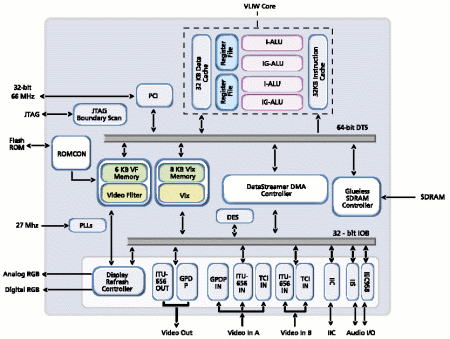Versatile A/V device reference design comes with Linux 2.6
Nov 12, 2004 — by Henry Kingman — from the LinuxDevices Archive — views Equator is shipping a hardware/software reference design based on an SoC (system-on-chip) with both RISC-like and DSP-like instructions. The “Babelfish” platform runs Linux 2.6 on a BSP-15 SoC, and targets IP-STBs (set-top-boxes), PVRs (personal video recorders), and digital media adapters.
Equator is shipping a hardware/software reference design based on an SoC (system-on-chip) with both RISC-like and DSP-like instructions. The “Babelfish” platform runs Linux 2.6 on a BSP-15 SoC, and targets IP-STBs (set-top-boxes), PVRs (personal video recorders), and digital media adapters.
(Click for slightly larger view of Babelfish)
Equator's BSP-15
Equator's “Broadband Signal Processor” (BSP) chips are single-core SoCs that combine RISC-like control processing instructions with high-performance signal and image processing instructions. They are supported by gcc-compatible compilers, and Equator offers an iMMediaTools SDK said to enable C/C++ programmers to write applications for BSP chips that process media efficiently.
Equator first announced Linux support for its BSP chips in March of 2003. BSP chips have an MMU, and can run full Linux (not just uClinux). The BSP-15 is clocked at 400MHz, and includes a range of peripherals targeting consumer electronic devices.

Equator BSP-15 diagram
(Click to enlarge)
The Babelfish platform
Equator says its Babelfish reference design offers OEMs (original equipment manufacturers) and ODMs (original design manufacturers) the industry's widest choices for codecs, DRM (digital rights management) solutions, middleware, networking, and streaming applications. The hardware design is scalable and modular, Equator says, while the Linux 2.6-based operating system allows open application expansion.
According to Equator, multiple “stuffing” options enable OEMs/ODMs to configure the platform for use as:
- Windows Media Streaming STB — compliant with Windows Media Main Profile, Windows Media Advanced Profile, Windows Media Transport, and Window Media DRM-10
- IP STB with USB 2.0 interface for gaming or HDD
- Optional local IDE drive for trickle-charging content
- Personal video recorder (PVR)
- Digital Media Adaptor — can play on TV PC-based content in Windows Media, RealVideo, DivX formats and digital photo albums
- Wireless Digital Media Adaptor — 802.11 a/b/g-enabled, multi-codec support enabled
CTO John O'Donnell said, “Babelfish brings together multiple network protocols, physical media, and A/V media formats, providing a compelling digital media delivery platform that's production-ready.”
Availability
The Babelfish Development Board is available from Equator immediately, along with the iMMediaTools Software Development Toolkit v6.1 and Linux 2.6. Equator says contract manufacturers are “on standby” to mass-produce OEM custom configurations derived from the Babelfish design.
Previous Equator reference designs based on the BSP-15 include the Tetra design, which shipped in 2002, and the Windows Media 9-capable Starfish, which arrived in April of this year.
This article was originally published on LinuxDevices.com and has been donated to the open source community by QuinStreet Inc. Please visit LinuxToday.com for up-to-date news and articles about Linux and open source.